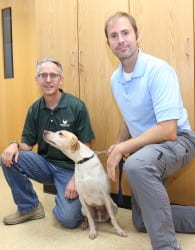Buggers of Brown County — Prof. Draney and friends fight to control bed bugs in Northeast Wisconsin

Watch out Northeast Wisconsin bed bugs, University of Wisconsin-Green Bay’s entomologist Mike Draney is coming after you.
If news about bed bugs makes you itch, just think if Draney, his friend Jon Sandberg ’11 (Interdisciplinary Studies) and Jon’s faithful bed bug-sniffing dog Chester, weren’t on the job.
They are members of the Brown County Bed Bug Task Force, with a focus on getting the word out to the public about this problem of epic proportions, with an end goal of reducing the spread of bed bugs through increased awareness.
 Before you ask the question… No, this story isn’t about bed bugs at UW-Green Bay. No, there hasn’t been a problem on campus. This is a story about a UW-Green Bay faculty member and alumnus using their expertise to make a different in the community.
Before you ask the question… No, this story isn’t about bed bugs at UW-Green Bay. No, there hasn’t been a problem on campus. This is a story about a UW-Green Bay faculty member and alumnus using their expertise to make a different in the community.
“Beg bugs will never be eliminated. There is no silver bullet,” Sandberg says. “In fact, there is evidence that they existed and were documented in 1352 B.C.”
Bed bugs aren’t a terrible medical problem, according to Draney. “They are not known to transmit any human diseases, and they don’t drink much blood. But, they are real social problem, because if there are bedbugs in your house, they can be moved to others’ houses. The reason they are getting to be a problem in Wisconsin is because they have become so resistant to so many pesticides used to control them, that they are now difficult to eliminate. And treatment can be very expensive.”
That’s where the high-energy Chester comes in… the approximately four-year old former stray was given a new lease on life when he showed the propensity to be trained as a bed-bug sniffer. The part Australian cattle dog, part terrier mix has a high “prey drive,” is good-natured and eager to work for his reward (food). He is also a great size, about 30 pounds, to get in tight spaces (such as under beds).
It turns out Chester is the perfect compliment to Sandberg, a veteran and a runner who is always on the go, and was looking for such a dog as he started his business, Sandberg K9 Solutions LLC, about three years ago. Unfortunately for Brown County, it’s a business, that is booming.
“We do about 800 inspections per year,” Sandberg says. “Bugs don’t discriminate,” he says. “They don’t care if you are rich, poor. One day we went from Section 8 housing, to assisted living to a $700,000 home. One time last September we were called to inspect a semi-load full of upholstery. An astute employee saw something suspicious. We were able to identify the bugs. Can you imagine if that upholstery had gotten into the shop? Thousand of dollars in fabrics would have been ruined and the potential for spreading to cars, trucks, classic cars…”
Using bed bug biology to control the problem
So why did UW-Green Bay Prof. Mike Draney get involved?
“The real harm that bed bugs cause is from people trying to manage them,” he explains. “People can damage their property and poison themselves and their environment with do-it-yourself treatments. I’m especially interested in the situation because awareness of bed bugs and knowledge of bed bug biology is key to dealing with them. For example, it is very bad practice to get rid of bed bug infested furniture by putting it out on the curb; you will very likely give the bed bug problem to the next owner.”
Draney said that although Brown County doesn’t have the acute bed bug problems of some of the big cities, they are spreading throughout the United States, and one is never completely safe from the threat of bed bugs.
“They have become a much larger problem in the Green Bay area in the last decade.”
Draney advises that the most important thing is to avoid introducing them into your home, which happens mainly when you travel. Here’s some helpful advice for those instances:
- Learn to look for bedbugs and their signs (their feces looks like dried blood), especially between mattresses and between the bed and the wall.
- Do a bed bug check before you move into a hotel room, and don’t stay in a suspicious room.
- When you return, put your travel clothes directly into the laundry to minimize the chance of any insects moving in.
For Facebook users, Draney asks that you “like” the Brown County Bed Bug Task Force Facebook page, both on your individual Facebook page, as well as your organization’s page. Secondly, inform your friends and coworkers to do the same and share any Brown County Bed Bug Task Force posts with your Facebook friends. If possible, post a link to the Brown County Bed Bug Task Force Facebook page to their organization’s website.
And if Brown County works to eliminate bedbugs, poor Chester is out of a job, right? “Not likely,” Sandberg said. “So often (maybe up to 90% of the time) people never see a thing. In fact, they often don’t feel bites, either. When bed bugs bite they inject an anesthetic and an anticoagulant that prevents a person from realizing they are being bitten. People will present raised red itchy welts (think like a mosquito bite x 10) after, but even about one-third of the population will not show any signs of being fed off of. Combine that with how well the bugs hide and this allows an infestation to grow.”
That is where Chester comes in. He trains extensively and daily to keep his nose sharp… And talk about sacrifice… bed bugs eat blood. In order to keep a live supply at his house for training, Sandberg has to provide his own blood as food.
“People say they give their blood, sweat and tears to a job… but do they really?” he jests, “It’s the sacrifice I make to do this. While others are home on a Saturday night, Chester and I are training in a vacant warehouse somewhere… but it’s the lifestyle we’ve chosen.
“We take the responsibility seriously,” he says. “There is an immense amount of pressure to get it right.” While Sandburg won’t say that Chester is 100% accurate, he said (as he knocks on wood) that in three years, he has never had a call that said he and Chester got it wrong.





